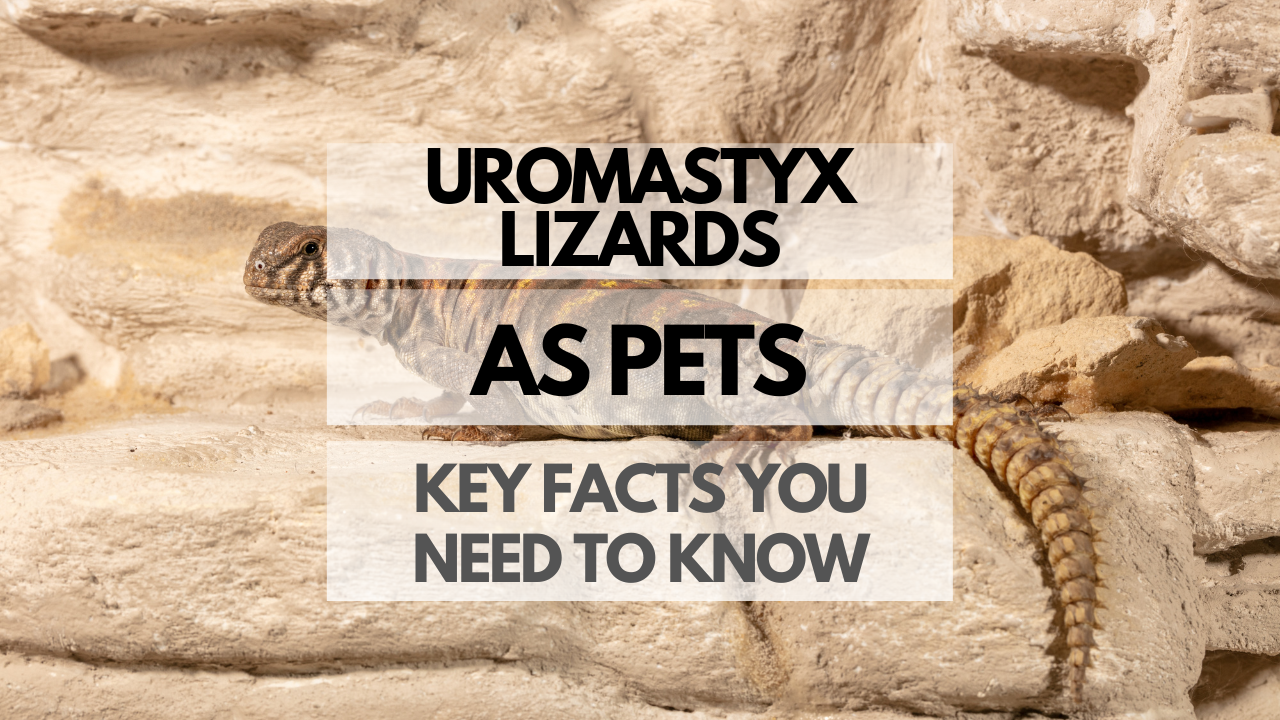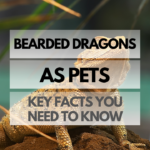Uromastyx lizards, also known as spiny-tailed lizards, are unique and fascinating reptiles native to North Africa and the Middle East. Their striking appearance, docile nature, and relatively low maintenance requirements have made them increasingly popular pets among reptile enthusiasts. Let’s dive into the world of Uromastyx and discover what makes them such captivating companions.
Quick Reference Table: Uromastyx Lizards Facts
| Fact | Details |
|---|---|
| Size | 10-36 inches, depending on the species |
| Lifespan | Up to 20 years or more in captivity |
| Temperament | Docile and relatively easy to handle |
| Price | $75-$400, depending on the species and rarity |
| Diet | Mainly herbivorous, with occasional insects |
How Are Uromastyx Lizards as Pets?
Uromastyx lizards make fantastic pets for those willing to dedicate time and effort to create a suitable environment for them. Their naturally calm temperament makes them easier to handle than many other reptiles, and their herbivorous diet simplifies feeding. However, it’s essential to research their specific needs to ensure their well-being and happiness.
Pros and Cons of Uromastyx Lizards
Pros:
- Docile and easy to handle
- Unique appearance and variety of colors
- Herbivorous diet simplifies feeding
Cons:
- Require a large, well-heated enclosure
- Can be sensitive to humidity and temperature changes
- Some species may be difficult to find or expensive
Uromastyx Behavior and Temperament
Uromastyx lizards are generally docile and easy to handle, making them excellent pets for beginners and experienced reptile owners alike. They are diurnal, meaning they are active during the day and sleep at night. While they can be shy initially, with patience and gentle handling, they will become more comfortable around their human caretakers.
How Much Do Uromastyx Lizards Cost?
Uromastyx lizards can range from $75 to $400, depending on the species and rarity. The initial setup for their habitat can be pricey, including a large tank, lighting, heating, and substrate. Ongoing expenses include food, supplements, and occasional veterinary care.
Uromastyx Lifespan: Time and Commitment
Uromastyx lizards can live up to 20 years or more in captivity with proper care. This long lifespan means that owning one is a significant commitment. It’s essential to provide a stable environment with consistent temperature and humidity, as well as a healthy diet, to ensure their well-being throughout their lives.
Uromastyx Size
Depending on the species, Uromastyx lizards can range in size from 10 to 36 inches. Smaller species like the Ornate Uromastyx typically reach 10 to 16 inches, while larger species like the Egyptian Uromastyx can grow up to 36 inches.
Uromastyx Species
There are several species of Uromastyx that differ in appearance, size, and care requirements. Let’s explore a few popular ones!
Ornate Uromastyx
One of the smaller species, the Ornate Uromastyx features a beautiful array of colors and patterns. They are relatively easy to care for, making them a popular choice for beginners.
Egyptian Uromastyx
The largest of the Uromastyx species, the Egyptian Uromastyx has a striking appearance with its spiky tail and earth-toned colors. They require a more spacious enclosure and are better suited for experienced keeprels.
Mali Uromastyx
The Mali Uromastyx is a medium-sized species with a stunning combination of green, yellow, and orange hues. They are relatively hardy and make great pets for those new to Uromastyx care.
Uromastyx Colors, Looks, and Appearances
Uromastyx lizards are known for their vibrant colors and unique appearances. Their patterns and hues vary among species and individuals, making each one a beautiful and captivating addition to your home. The spiny tail, which gives them their name, is a distinctive feature that sets them apart from other lizards.
Uromastyx Care Guide
Caring for a Uromastyx lizard involves providing a suitable habitat, consistent temperature and humidity, a nutritious diet, and regular monitoring of their health. Let’s explore the essential components of Uromastyx care.
Uromastyx Habitat: Tank and Housing
Creating a comfortable and safe environment for your Uromastyx is crucial to their well-being. The following aspects should be considered when setting up their habitat:
Appropriate Uromastyx Tank Size
The size of the tank will depend on the species of Uromastyx you own. Smaller species require a minimum of a 40-gallon enclosure, while larger species need at least a 75-gallon tank. Remember, bigger is always better, allowing them more space to explore and thrive.
Types of Enclosures
Choose a well-ventilated glass or plastic enclosure with a secure lid. This will help maintain proper temperature and humidity levels while keeping your Uromastyx safe.
Substrate Options
Use a substrate that is easy to clean and allows for burrowing, such as a mixture of play sand and topsoil. Avoid using substrates that can cause impaction if ingested, such as calcium sand or small gravel.
Heating and Lighting Requirements
Uromastyx lizards require a basking spot with temperatures between 110-120°F (43-49°C) and a cooler area with temperatures around 80°F (27°C). Provide a high-quality heat lamp for basking and a UVB light to support their overall health.
Humidity and Temperature Control
Uromastyx lizards are accustomed to arid environments, so maintaining low humidity levels (30-40%) is essential. Monitor temperature and humidity levels regularly and adjust as needed to ensure a stable environment.
Furnishings and Decorations
Provide your Uromastyx with hiding spots, such as caves or hollow logs, and climbing opportunities like branches or rocks to create a stimulating environment that mimics their natural habitat.
Cleaning and Maintenance
Regularly spot clean the enclosure, removing any waste or uneaten food. Perform a deep clean of the entire habitat, including replacing the substrate, every three to four months to maintain a clean and healthy environment for your Uromastyx.
Uromastyx Lizards Food: Diet and Nutrition
Feeding Frequency and Schedule
Uromastyx lizards are primarily herbivores and should be fed a variety of leafy greens, vegetables, and seeds daily. Adults can be fed once a day, while juveniles should be fed twice a day to support their growth.
What do Uromastyx Lizards Eat?
Uromastyx lizards enjoy a diet consisting of leafy greens (collard, mustard, and dandelion greens), vegetables (squash, bell peppers, and zucchini), and seeds (lentils, millet, and quinoa). Occasionally, they can eat small amounts of fruit as a treat.
Uromastyx Lizards Treats
As an occasional treat, you can offer your Uromastyx small amounts of fruit like berries, apples, or melon. However, fruit should only make up a small portion of their diet, as it can cause digestive issues if fed too frequently.
Foods to Avoid
Avoid feeding your Uromastyx insects, as they are herbivores and do not require insects in their diet. Additionally, steer clear of lettuce, spinach, and rhubarb, as these can be harmful or offer little nutritional value.
Supplements and Vitamins
Supplement your Uromastyx’s diet with calcium and vitamin D3 powder to ensure they receive the proper nutrients for healthy bone development. Dust their food with the supplements a few times a week, following the manufacturer’s recommendations.
Hydration
Uromastyx lizards get most of their hydration from their food. However, providing a shallow water dish is still recommended, especially during shedding, to help maintain proper humidity levels in their enclosure.
Handling and Socialization
Taming and Bonding
Patience is key when taming and bonding with your Uromastyx. Start by offering food from your hand and gradually progress to gentle handling once your lizard becomes more comfortable with your presence. Always handle them with care and avoid sudden movements.
Safe Handling Techniques
When handling your Uromastyx, approach them slowly and let them crawl onto your hand. Support their body weight with both hands and avoid grabbing or squeezing them. Remember to wash your hands before and after handling any reptile to prevent the spread of bacteria.
Signs of Stress and Illness
Signs of stress or illness in Uromastyx lizards include lethargy, loss of appetite, excessive hiding, and labored breathing. If you notice any of these signs, consult a reptile veterinarian for proper care and treatment.
Introducing Uromastyx Lizards to Other Pets
Introducing Uromastyx lizards to other pets should be done with caution, as they can be territorial. It’s best to house them separately and only allow supervised interaction with other non-aggressive reptiles under close supervision.
Health and Wellness
Common Health Issues
Some common health issues in Uromastyx lizards include metabolic bone disease, impaction, respiratory infections, and parasites. Regular check-ups with a reptile veterinarian can help catch and treat these issues early on.
Signs of a Healthy Uromastyx Lizard
A healthy Uromastyx lizard will be alert, active, and have a good appetite. Their skin should be free of sores, and their eyes should be bright and clear. A proper diet and clean environment contribute to their overall health and well-being.
Preventative Care
Preventative care for your Uromastyx includes regular cleaning of their enclosure, providing a balanced diet, and routine check-ups with a reptile veterinarian. These measures will help ensure your pet stays healthy and happy throughout their life.
Finding a Reptile Veterinarian
Locate a reptile veterinarian in your area who specializes in Uromastyx care, as not all vets are experienced with reptiles. Ask for recommendations from other reptile owners or local reptile clubs to find a trusted veterinarian.
Breeding and Reproduction
Determining Gender
Sexing Uromastyx lizards can be difficult, as males and females share similar physical characteristics. However, males tend to be larger and have more prominent femoral pores than females. Consult a reptile expert or veterinarian for accurate sexing.
Mating Behavior and Courtship
During the breeding season, male Uromastyx lizards will display courtship behaviors such as head-bobbing, body-waving, and chasing the female. It’s essential to provide separate hiding spaces and monitor the pair closely to prevent aggression or injury.
Gravidity and Egg-laying
After successful mating, a female Uromastyx will become gravid and start developing eggs. Provide a suitable nesting area with a mixture of sand and soil for her to lay her eggs. Egg-laying typically occurs 4-6 weeks after mating.
Incubation and Hatching
Uromastyx eggs should be incubated in a separate container with a mixture of vermiculite and water. Maintain the temperature between 85-90°F (29-32°C) for optimal hatching success. Eggs will typically hatch after 70-90 days of incubation.
Caring for Hatchlings
Once the hatchlings emerge, they should be housed separately from the adults and provided with a smaller-scaled version of an adult enclosure. Feed them a balanced diet of greens, vegetables, and seeds, and monitor their growth and health closely.
Are Uromastyx Lizards Legal?
Uromastyx lizards are legal to own as pets in most countries, but local laws and regulations may vary. Always check with your local authorities or wildlife department before acquiring a Uromastyx lizard to ensure you are compliant with any requirements or restrictions.
Popular Names for Uromastyx Lizards
Looking for a fun and unique name for your Uromastyx lizard? Here are some ideas to get you started:
- Spike
- Rocky
- Stella
- Mango
- Zeus
- Luna
- Jade
- Blaze
Conclusion: Should You Own Uromastyx Lizards as Pets?
Uromastyx lizards can make fascinating and rewarding pets for those willing to provide proper care and attention. They require a balanced diet, a clean environment, and regular check-ups with a reptile veterinarian. If you’re up for the challenge, owning a Uromastyx lizard can be a unique and enjoyable experience. Remember to research and prepare for your new pet, and always practice responsible ownership!
FAQ for Pet Uromastyx Lizards
Q: Are Uromastyx Lizards good pets?
A: Uromastyx Lizards can make fascinating and low-maintenance pets for those who provide proper care and are willing to invest time in handling and socializing them.
Q: Can Uromastyx Lizards eat grapes?
A: Grapes can be given as an occasional treat but should not be a staple food in their diet.
Q: Can Uromastyx Lizards eat bananas?
A: Bananas can be offered as an occasional treat, but should not make up a significant portion of their diet.
Q: Can Uromastyx Lizards eat strawberries?
A: Strawberries can be fed in moderation as a treat, but should not be a regular part of their diet.
Q: Can Uromastyx Lizards eat apples?
A: Apples can be given as an occasional treat, but should not be a staple in their diet.
Q: Can Uromastyx Lizards eat spinach?
A: Spinach should be avoided, as it contains oxalates that can interfere with calcium absorption.
Q: Can Uromastyx Lizards eat tomatoes?
A: Tomatoes should not be fed to Uromastyx Lizards, as they are too acidic and can cause digestive issues.
Q: Can Uromastyx Lizards eat carrots?
A: Carrots can be fed to Uromastyx Lizards sparingly, as they are high in oxalates and should not be a dietary staple.
Q: Can Uromastyx Lizards eat cucumbers?
A: Cucumbers can be fed occasionally but have little nutritional value and should not be a staple food.
Q: Can Uromastyx Lizards eat watermelon?
A: Watermelon can be fed as an occasional treat, but should not be a significant part of their diet.
Q: Can Uromastyx Lizards eat broccoli?
A: Broccoli can be fed in moderation, but it should not be a staple food, as it can interfere with iodine absorption.
Q: Can Uromastyx Lizards eat blueberries?
A: Blueberries can be offered as an occasional treat but should not be a significant part of their diet.
Q: Can Uromastyx Lizards eat celery?
A: Celery can be fed occasionally, but it has little nutritional value and should not be a dietary staple.
Q: Can Uromastyx Lizards eat cabbage?
A: Cabbage can be fed occasionally, but it should not be a staple food, as it can cause digestive issues.
Q: Can Uromastyx Lizards eat cilantro?
A: Cilantro can be fed occasionally, but it should not be a staple food in their diet.
Q: Can Uromastyx Lizards eat kale?
A: Kale can be fed in moderation, but it should not be a dietary staple, as it can interfere with calcium absorption.
Q: Can Uromastyx Lizards eat blackberries?
A: Blackberries can be offered as an occasional treat, but should not be a significant part of their diet.
Q: Can Uromastyx Lizards eat oranges?
A: Oranges should be avoided, as they are too acidic and can cause digestive issues.
Q: Can Uromastyx Lizards eat avocados?
A: Avocados should not be fed to Uromastyx Lizards, as they contain a toxin called persin that can be harmful to them.
Q: Can Uromastyx Lizards eat corn?
A: Corn can be fed occasionally, but it should not be a staple food in their diet, as it has little nutritionalvalue.
Q: Can Uromastyx Lizards eat asparagus?
A: Asparagus can be fed occasionally, but it should not be a dietary staple, as it can interfere with calcium absorption.
Q: How often do Uromastyx Lizards eat?
A: Adult Uromastyx Lizards typically eat every 1-3 days, while juveniles may eat daily.
Q: How long do Uromastyx Lizards live?
A: Uromastyx Lizards can live for 15-30 years or more, depending on the species and quality of care provided.
Q: Where are Uromastyx Lizards native?
A: Uromastyx Lizards are native to North Africa, the Middle East, and parts of Asia.
Q: Are Uromastyx Lizards friendly?
A: Uromastyx Lizards can become friendly and docile with regular handling and socialization, but their temperament can vary depending on the individual and the species.
Q: Do Uromastyx Lizards bite?
A: Uromastyx Lizards may bite if they feel threatened or stressed. Proper handling and socialization can help reduce the likelihood of biting.
Q: Do Uromastyx Lizards like to be held?
A: Many Uromastyx Lizards tolerate handling well, especially if they have been socialized from a young age. However, it’s essential to be gentle and support their bodies properly during handling.
Q: Are Uromastyx Lizards nocturnal?
A: Uromastyx Lizards are diurnal, meaning they are active during the day and sleep at night.
Q: Do Uromastyx Lizards pee?
A: Uromastyx Lizards excrete uric acid, a solid waste product, instead of liquid urine like mammals. This helps them conserve water in their native arid environments.
Q: Do Uromastyx Lizards hibernate?
A: Uromastyx Lizards do not hibernate, but they may enter a state called brumation, which is similar to hibernation, during cooler months or when environmental conditions are not optimal.
Q: Do Uromastyx Lizards make noise?
A: Uromastyx Lizards are generally quiet pets, but they may make occasional hissing, puffing, or clicking noises, especially when they feel threatened or stressed.
Q: Are Uromastyx Lizards venomous or poisonous?
A: Uromastyx Lizards are neither venomous nor poisonous and are considered safe to handle by humans.
Q: Are Uromastyx Lizards smart?
A: Uromastyx Lizards demonstrate some degree of intelligence and can learn to recognize their owners and respond to their presence.
Q: Do Uromastyx Lizards need heat at night?
A: Uromastyx Lizards generally do not require supplemental heat at night, as long as their enclosure temperature does not drop below 70°F (21°C).
Q: Do Uromastyx Lizards lay eggs?
A: Uromastyx Lizards are oviparous, meaning they lay eggs. Females will lay a clutch of eggs in a burrow they dig in their enclosure.
Q: Do Uromastyx Lizards smell?
A: Uromastyx Lizards are relatively odor-free pets, as long as their enclosures are kept clean and properly maintained.









